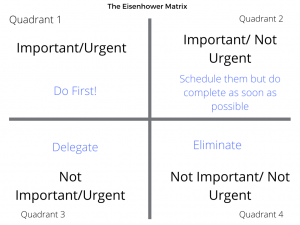
2 MINUTE READ
Written by Jabiha Razi
Most of us are hard-pressed for time. With so many personal and professional commitments vying for our limited time, we often lose where to begin. As a result, by the end of the day, we are stressed out because of some critical task remaining incomplete or feeling guilty of not giving any time to our loved ones. Helpful time management tools can help us in getting over such problems.
Eisenhower matrix is a practical and easy-to-understand time management tool that helps increase productivity. It was invented by US President Dwight D. Eisenhower, who used to manage his tasks on a day-to-day basis on its principles.
The matrix breaks down your tasks into two dimensions: importance and urgency. It has four quadrants that set the priority level for each task. Some jobs are essential (not doing them will lead to adverse outcomes), and some are more time-sensitive and, hence, urgent. Keep in mind that urgency and importance vary from person to person. So, a task essential or critical for one person may not be so for another.

Before you begin your day, divide your tasks into these quadrants. The jobs that fall in quadrant one are the ones you must do first, mainly on the same day. Not completing them immediately will have an adverse impact. Two examples of such tasks are a time-sensitive proposal that you may have to submit to your client today or a decision that you need to take today for tomorrow’s product launch. If you do not prioritize these jobs, you might lose out on business.
The tasks in quadrant two are essential, and you must never ignore them, even if they are not urgent. Therefore, always schedule them for later action and stick to that schedule. For instance, staying in touch with relevant decision-makers and influencers at your client’s office may not be urgent but may affect your relationship with the client in the future. So set a meeting date for the same, and don’t procrastinate. Remember, quadrant two is where you should spend most of your time to have a more fulfilling and enriching personal and professional life.
Tasks that fall in quadrant three are less important yet urgent. It would be best if you delegated them. Once you transfer them, you still have to ensure the assigned person finishes them on time. For instance, a virtual assistant could send invitations to a conference within a specified time.
Quadrant four tasks take the least priority and should be avoided, and are generally “time wasters”. An example is constantly surfing the net without reason. If you could identify and stop doing such tasks or at least reduce the time spent on them, you would have more time for quadrant two.
Log the time for a week that you spend on various tasks to check which quadrant you spend most of your time.
